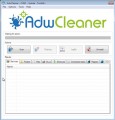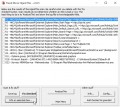The protectivepcs.com is a misleading ad page. This fake alert is created to scare you into thinking that your computer have a lot of heavy problems with security, drivers, malware, Internet connection, etc and thus force you to call remote tech support service (+64-800-003-543). Most often, it is loaded into your browser with the help of adware. The adware may change the settings of browsers like Google Chrome, Mozilla Firefox, Internet Explorer and Edge or install a malicious browser extension, which created to generate a lot of annoying pop-up ads. It will lead to the fact that when you open the web-browser or surfing the World Wide Web, it will always be forced to open protectivepcs.com advertisements, even when your browser is configured to stop pop-up ads or your PC has a program that stops advertisements. On current date, the ad supported software continues to increase the number of PCs that have been infected.
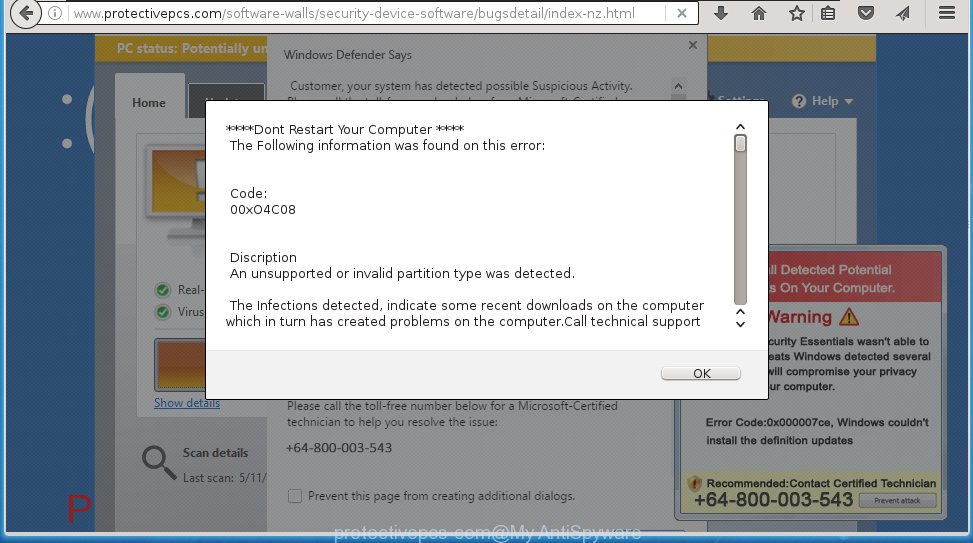
http://www.protectivepcs.com/software-walls/security-device-software/bugsdetail – Fake alert
The adware usually affects only the Internet Explorer, Chrome, Firefox and Microsoft Edge by changing the internet browser’s settings or installing a malicious extensions (addons). Moreover, possible situations, when any other web-browsers will be affected too. The ad supported software will perform a scan of the system for web-browser shortcuts and modify them without your permission. When it infects the internet browser shortcuts, it will add the argument such as ‘http://site.address’ into Target property. So, each time you start the browser, you will see an annoying protectivepcs.com page.
The ad supported software may insert a huge number of advertising links directly to the web-sites that you visit, creating a sense that the ads has been added by the creators of the site. Moreover, a legal advertising links may be replaced on the fake advertising links, that will offer to download and install various unnecessary and harmful programs. Moreover, the adware has the ability to collect a large number of personal information about you (your ip address, what is a web page you are viewing now, what you are looking for on the World Wide Web, which links you are clicking), which can later transfer to third parties.
Instructions, which is shown below, will allow you to clean your computer from the ad supported software infection and get rid of protectivepcs.com unwanted advertising from the Google Chrome, Mozilla Firefox, Internet Explorer and Edge and other browsers.
How does protectivepcs.com pop-ups get installed onto system
The adware usually come bundled with other freeware that you download off of the Net. Once started, it will infect your system and configure your browser’s to open lots of the protectivepcs.com annoying ads without your permission. To avoid infection, in the Setup wizard, you should be be proactive and carefully read the ‘Terms of use’, the ‘license agreement’ and other installation screens, as well as to always choose the ‘Manual’ or ‘Advanced’ installation mode, when installing anything downloaded from the Internet.
How to manually remove protectivepcs.com redirect
This guide will help you remove protectivepcs.com ads. These protectivepcs.com removal steps work for the Internet Explorer, Chrome, Firefox and Microsoft Edge, as well as every version of Windows operating system. Some of the steps may require you to close the browser or reboot your personal computer. So, bookmark or print it for later reference.
- Remove suspicious and unknown software by using Windows Control Panel
- Disinfect the browser’s shortcuts to remove protectivepcs.com redirect
- Delete protectivepcs.com popup ads from Chrome
- Remove protectivepcs.com advertisements from Firefox
- Uninstall protectivepcs.com pop-up ads from IE
Remove suspicious and unknown software by using Windows Control Panel
First, you should try to identify and uninstall the program that causes the appearance of unwanted advertisements and browser redirect to unwanted web pages, using the ‘Uninstall a program’ which is located in the ‘Control panel’.
Windows 8, 8.1, 10
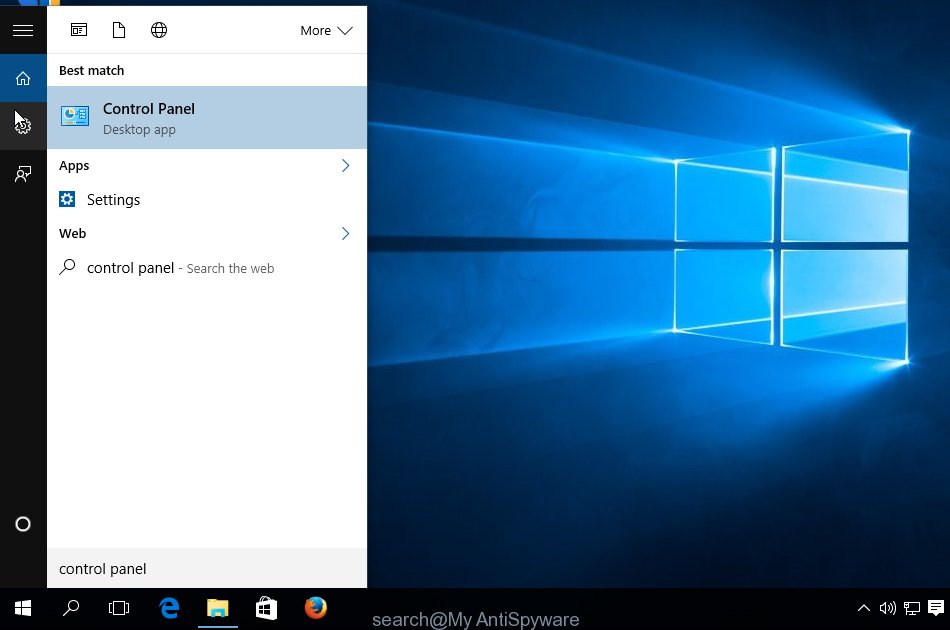 When the ‘Control Panel’ opens, click on the ‘Uninstall a program’ link under Programs category as shown below.
When the ‘Control Panel’ opens, click on the ‘Uninstall a program’ link under Programs category as shown below. 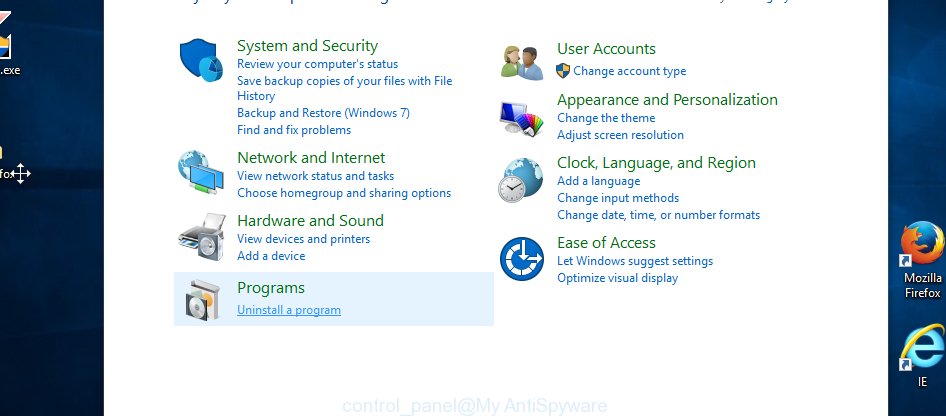 You will see the ‘Uninstall a program’ panel. Look on the example below.
You will see the ‘Uninstall a program’ panel. Look on the example below.  Very carefully look around the entire list of installed programs. Most likely, one or more of them are responsible for the browser redirect to the unwanted protectivepcs.com web-site. If you have many programs installed, you can help simplify the search of malicious software by sort the list by date of installation. Once you have found a suspicious, unwanted or unused program, right click to it and press ‘Uninstall’.
Very carefully look around the entire list of installed programs. Most likely, one or more of them are responsible for the browser redirect to the unwanted protectivepcs.com web-site. If you have many programs installed, you can help simplify the search of malicious software by sort the list by date of installation. Once you have found a suspicious, unwanted or unused program, right click to it and press ‘Uninstall’.
Windows XP, Vista, 7
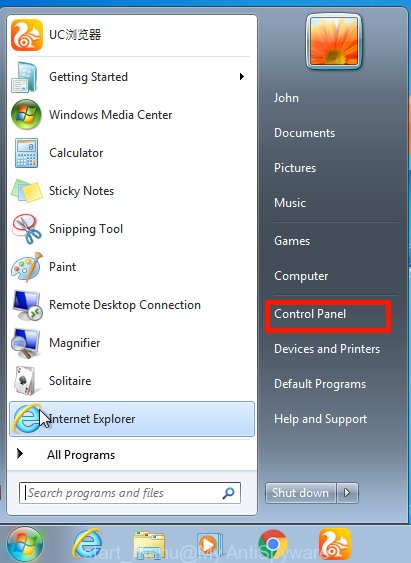 When the Windows ‘Control Panel’ opens, you need to click ‘Uninstall a program’ under ‘Programs’ as shown on the screen below.
When the Windows ‘Control Panel’ opens, you need to click ‘Uninstall a program’ under ‘Programs’ as shown on the screen below. 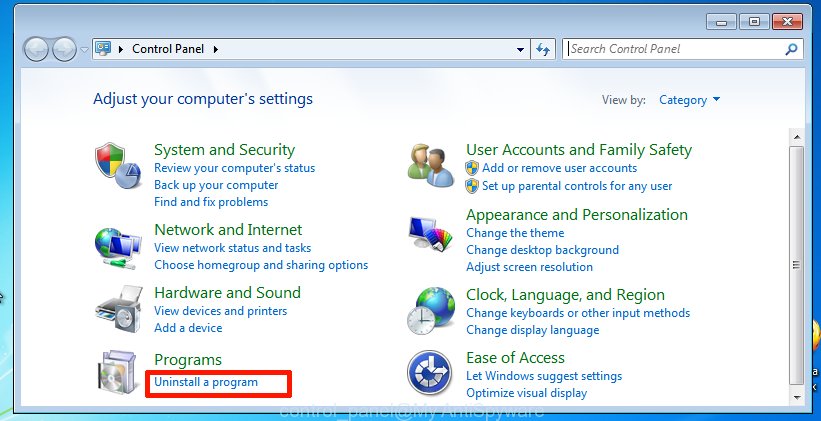 You will see a list of programs installed on your PC system. We recommend to sort the list by date of installation to quickly find the programs that were installed last. Most likely they responsibility for the appearance of pop-up ads and web-browser redirect. If you are in doubt, you can always check the program by doing a search for her name in Google, Yahoo or Bing. When the program, you want to remove, is found, simply click on its name, and then press ‘Uninstall’ as on the example below.
You will see a list of programs installed on your PC system. We recommend to sort the list by date of installation to quickly find the programs that were installed last. Most likely they responsibility for the appearance of pop-up ads and web-browser redirect. If you are in doubt, you can always check the program by doing a search for her name in Google, Yahoo or Bing. When the program, you want to remove, is found, simply click on its name, and then press ‘Uninstall’ as on the example below. 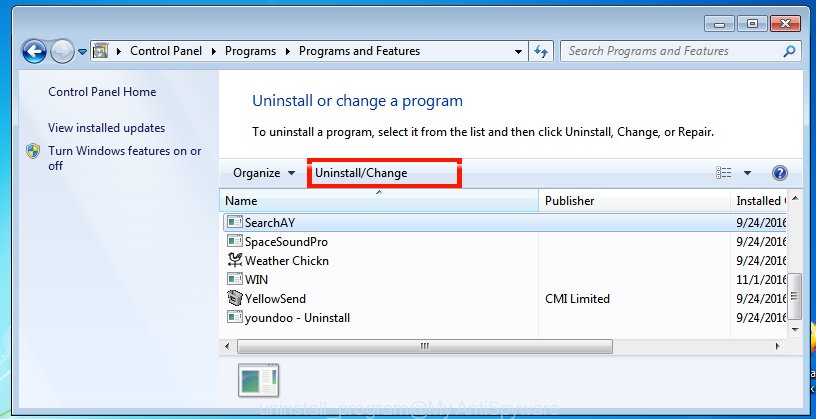
Disinfect the browser’s shortcuts to remove protectivepcs.com redirect
Now you need to clean up the internet browser shortcuts. Check that the shortcut referring to the right exe-file of the browser, and not on any unknown file. Right click to a desktop shortcut for your web-browser. Choose the “Properties” option.
It will open the Properties window. Select the “Shortcut” tab here, after that, look at the “Target” field. The adware can replace it. If you are seeing something like “…exe http://web.site.address” then you need to remove “http…” and leave only, depending on the web-browser you are using:
- Google Chrome: chrome.exe
- Opera: opera.exe
- Firefox: firefox.exe
- Internet Explorer: iexplore.exe
Look at the example on the screen below. 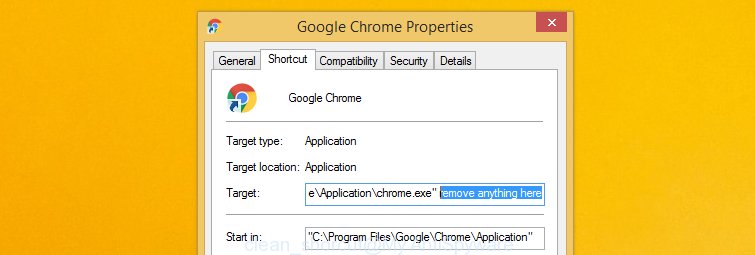 Once is done, press the “OK” button to save the changes. Please repeat this step for browser shortcuts which redirects to an annoying web-pages. When you have completed, go to next step.
Once is done, press the “OK” button to save the changes. Please repeat this step for browser shortcuts which redirects to an annoying web-pages. When you have completed, go to next step.
Delete protectivepcs.com popup ads from Chrome
Open the Google Chrome menu by clicking on the button in the form of three horizontal stripes (![]() ). It opens the drop-down menu. Click to Settings option.
). It opens the drop-down menu. Click to Settings option.  Scroll down to the bottom of the page and click on the “Show advanced settings” link. Now scroll down until the Reset settings section is visible, as shown below and click on the Reset settings button.
Scroll down to the bottom of the page and click on the “Show advanced settings” link. Now scroll down until the Reset settings section is visible, as shown below and click on the Reset settings button. 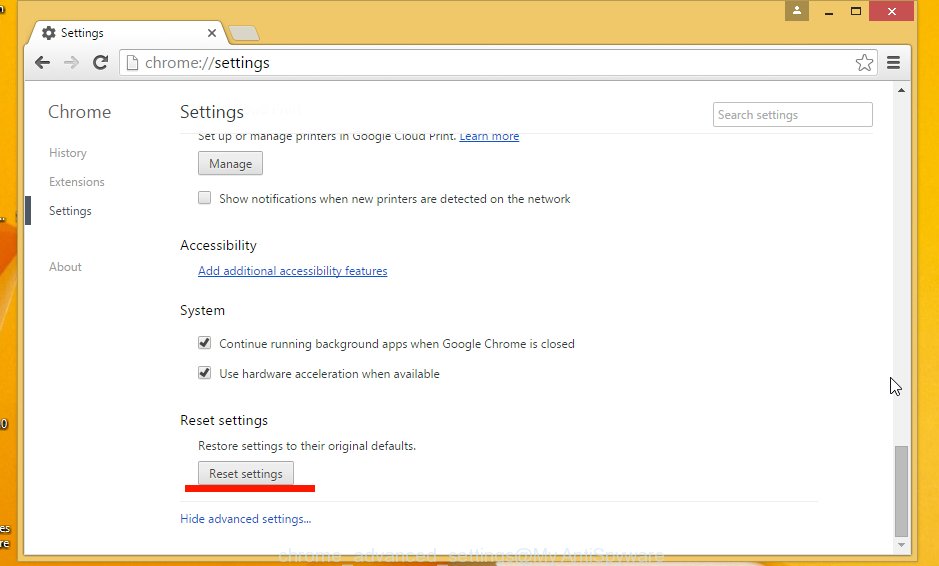 Confirm your action, click on the Reset button.
Confirm your action, click on the Reset button.
Remove protectivepcs.com advertisements from Firefox
If the Mozilla Firefox settings have been changed by the adware, then resetting it to the default state can help you to remove the redirect onto protectivepcs.com ads.
Run the Firefox and press ![]() button to display the Tools menu. It opens the drop-down menu on the right-part of the internet browser. Click on the Help button (
button to display the Tools menu. It opens the drop-down menu on the right-part of the internet browser. Click on the Help button (![]() ).
).  In the Help menu, select the “Troubleshooting Information” option. Another way to open the “Troubleshooting Information” screen – type about:support in the browser adress bar and press Enter. It will show the “Troubleshooting Information” page. In the upper-right corner of this screen, press the “Refresh Firefox” button.
In the Help menu, select the “Troubleshooting Information” option. Another way to open the “Troubleshooting Information” screen – type about:support in the browser adress bar and press Enter. It will show the “Troubleshooting Information” page. In the upper-right corner of this screen, press the “Refresh Firefox” button.  It will display the confirmation dialog box. Click on the “Refresh Firefox” button. The FF will start a task to fix your problems that caused by the adware. Once, it’s done, press the “Finish” button
It will display the confirmation dialog box. Click on the “Refresh Firefox” button. The FF will start a task to fix your problems that caused by the adware. Once, it’s done, press the “Finish” button
Uninstall protectivepcs.com pop-up ads from IE
Open the Microsoft Internet Explorer tools menu by clicking on the button in the form of gear (![]() ). It opens the drop-down menu. Click on the “Internet Options”.
). It opens the drop-down menu. Click on the “Internet Options”.  In the Internet Options window click on the Advanced tab, then click the Reset button. The Internet Explorer will show the “Reset Internet Explorer settings” window. Select the “Delete personal settings” check box, then click on “Reset” button.
In the Internet Options window click on the Advanced tab, then click the Reset button. The Internet Explorer will show the “Reset Internet Explorer settings” window. Select the “Delete personal settings” check box, then click on “Reset” button.  You will now need to restart your computer for the changes to take effect.
You will now need to restart your computer for the changes to take effect.
Remove protectivepcs.com automatically
You can remove protectivepcs.com popup ads automatically with a help of Malwarebytes Anti Malware Free. We recommend this free malware removal tool because it can easily delete adware, browser hijackers, potentially unwanted software and toolbars with all their components such as files, folders and registry entries.
Use the link below to download MalwareBytes Anti-malware Free on your computer. Save it on your desktop.
327725 downloads
Author: Malwarebytes
Category: Security tools
Update: April 15, 2020
Once the downloading process is complete, close all windows on your PC. Further, launch the file named mbam-setup. When a “Security warning” prompt pops up as shown below, click the Run button.
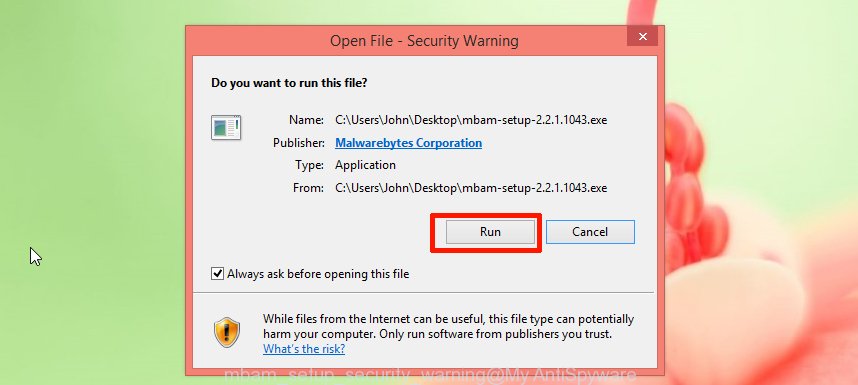
It will display the “Setup wizard” screen that will assist you install MalwareBytes Anti-malware on the computer. Follow the prompts and do not make any changes to default settings.
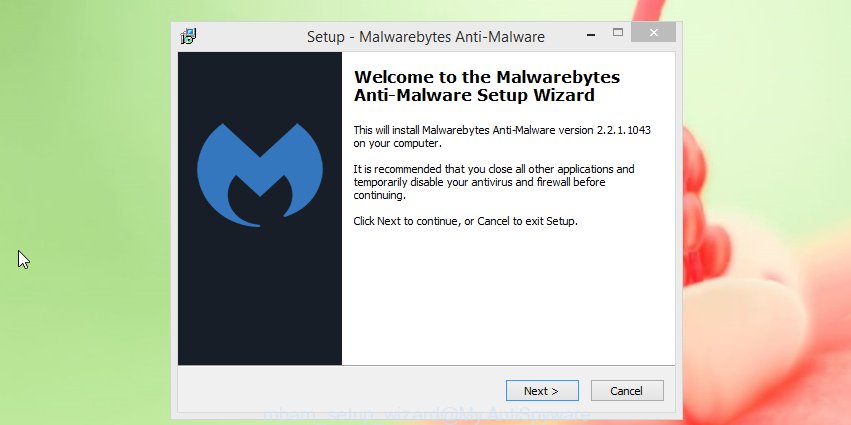
Once install is finished successfully, click Finish button. Then MalwareBytes Anti-malware will automatically start and you can see its main window as shown below.
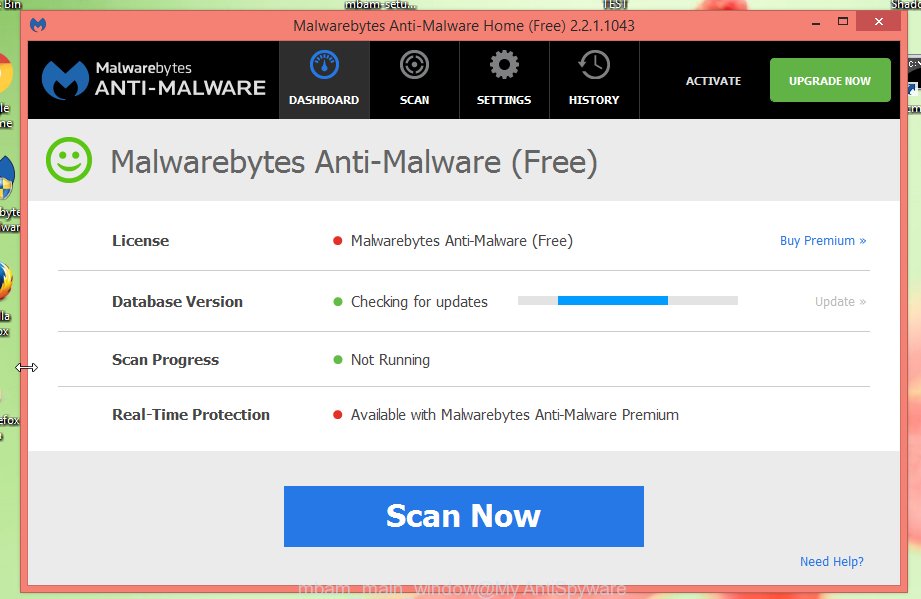
Next, press the “Scan Now” button to begin scanning your computer for the adware that cause a redirect to protectivepcs.com. When a threat is found, the number of the detected objects will change accordingly. Wait until the the scanning is finished. Please be patient.

As the scanning ends, you can check all threats detected on your PC. Make sure all entries have “checkmark” and click “Remove Selected” button.
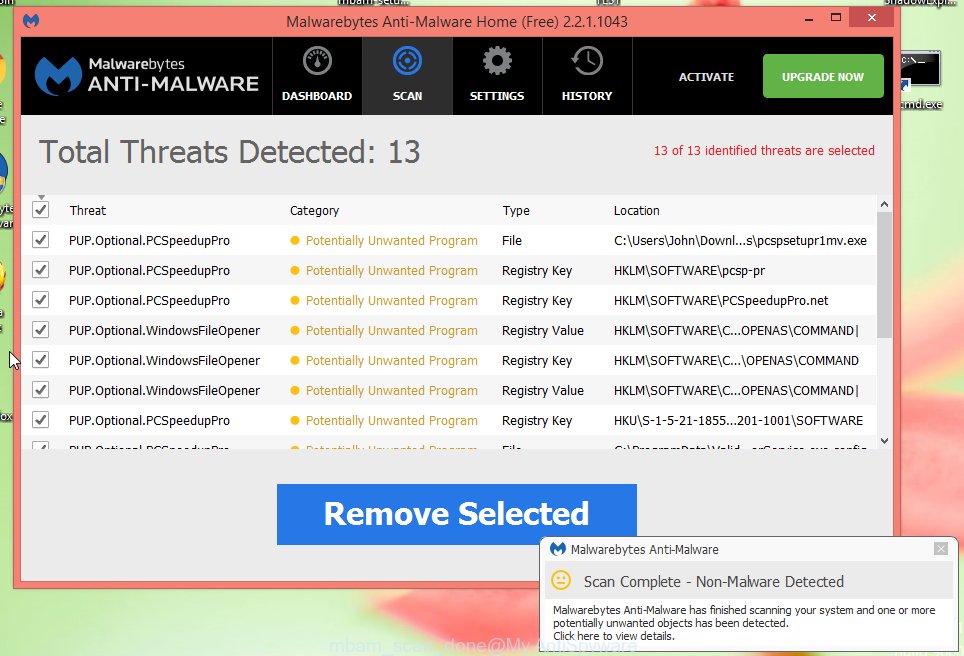
The MalwareBytes Anti-malware will begin removing protectivepcs.com ads and other security threats. Once disinfection is finished, you may be prompted to Restart. I recommend you look at the following video, which completely explains the process of using the Anti-malware to remove ad supported software and other dangerous software.
Stop protectivepcs.com pop-up ads and other unwanted web sites
To increase your security and protect your system against new annoying advertisements and malicious sites, you need to use program that blocks access to malicious advertising links and sites. Moreover, the software can block the show of intrusive advertising, which also leads to faster loading of pages and reduce the consumption of web traffic.
Download AdGuard program using the following link.
27036 downloads
Version: 6.4
Author: © Adguard
Category: Security tools
Update: November 15, 2018
After the download is complete, run the downloaded file. You will see the “Setup Wizard” screen as shown below.

Follow the prompts. After installation is complete, you will see a window as shown in the figure below.

You can click “Skip” to close the installation program and use the default settings, or press “Get Started” button to see an quick tutorial that will help you get to know AdGuard better.
In most cases, the default settings are enough and you do not need to change anything. Each time, when you start your system, AdGuard will run automatically and block pop-up ads, pages such protectivepcs.com, as well as other dangerous or misleading sites. For an overview of all the features of the application, or to change its settings you can simply double-click on the AdGuard icon, which is located on your Windows desktop.
If the problem with protectivepcs.com advertisements is still remained
If MalwareBytes Anti-malware cannot remove the protectivepcs.com , then we suggests to use the AdwCleaner. AdwCleaner is a free removal tool for adware, browser hijackers, PUPs, toolbars. Also you can ask for help our Myantispyware team below.
- Download AdwCleaner from the link below. AdwCleaner download
225789 downloads
Version: 8.4.1
Author: Xplode, MalwareBytes
Category: Security tools
Update: October 5, 2024
- Double click the AdwCleaner icon. Once this tool is started, press “Scan” button to perform a system scan for the ad supported software that generates the protectivepcs.com advertising links.
- Once AdwCleaner has finished, it will open a scan report. Review the report and then click “Cleaning” button. It will open a prompt. Click “OK”.
How to ask for help the Myantispyware team
If you are seeking a help for protectivepcs.com removal then follow these steps.
- Download HijackThis from the link below and save it to your Desktop. HijackThis download
5316 downloads
Version: 2.0.5
Author: OpenSource
Category: Security tools
Update: November 7, 2015
- Double-click on the HijackThis icon, and click the button labeled “Do a system scan only”.
- Once the scan is complete, the scan button will read “Save log”, click it. Save this log to your desktop
Create a Myantispyware account here. Once you’ve registered, check your e-mail for a confirmation link, and confirm your account. After that, login.
- Copy and paste the contents of the HijackThis log into your post. If you are posting for the first time, please start a new thread by using the “New Topic” button in the Spyware Removal forum. When posting your HJT log, try to give us some details about your problems, so we can try to help you more accurately.
- Wait for one of our trained “Security Team” or Site Administrator to provide you with knowledgeable assistance tailored to your problem with the redirect to the annoying protectivepcs.com pop-ups.

